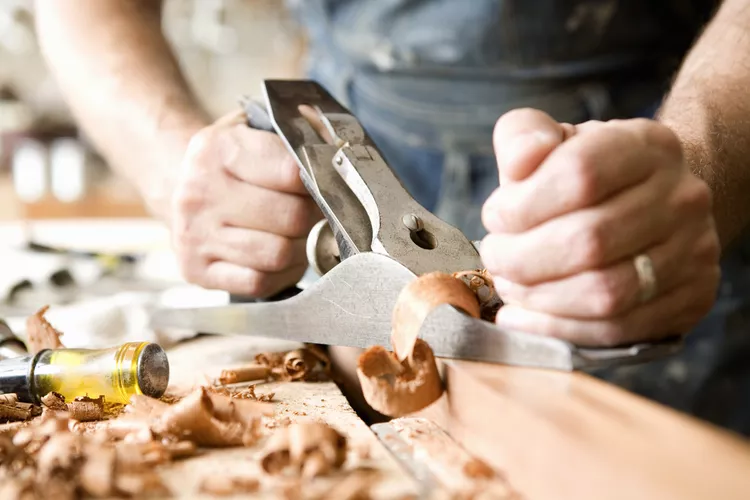How to Use a Hand Plane

A hand plane allows you to smooth and reshape wood efficiently without splurging on pricey power tools. Plus, a hand plane can do things power tools like jointers, electric planers, and routers can’t. They might look like rudimentary hand tools, but hand planes are precision woodworking instruments used to shave paper-thin slices of wood.
While it doesn’t take much know-how to understand the basics of a hand plane, using one effectively comes with practice and experience. We’ve provided a step-by-step tutorial on how to use a hand plane to flatten, reshape, and smooth rough wood surfaces.
What Is a Hand Plane?
A hand plane is a handheld tool with an adjustable, angled blade protruding from the bottom, which allows you to shave wood at a controlled depth.
Types of Hand Planes
Most types of hand planes are slight variations of the same basic design. However, minor design changes permit some types of hand planes to serve specific purposes, such as smoothing boards, trimming moldings, cleaning up mortise and tenon joints, and cleaning out routed slots in wood such as dadoes and rabbets.
The different types of hand planes you’ll come across include:
- Bench plane
- Pocket plane
- Smoothing plane
- Block plane
- Shoulder plane
- Chisel plane
- Router plane
- Jointer plane
- Bullnose plane
While each of these hand plane types has its place, we recommend beginners start with a large bench plane, an essential tool for any level of woodworker. A bench plane is a two-handed tool with a large shoe that helps it span a wide area of the wood, aiding in the ability to flatten and smooth the wood. A bench plane is one of the easiest hand planes to master and will give you a feel for hand planing before moving on to more specialty hand planes.
Safety Considerations
The blade of a properly sharpened hand plane is razor-sharp. Never place your hands on the underside of a hand plane for any reason. When using the tool, keep a firm grasp on the handle and the knob to keep yourself out of harm’s way in case the hand plane slips, and always operate the tool by pushing it away from your body. For smaller hand planes that require one-handed operation, keep your free hand behind the hand plane.
What You’ll Need
Equipment / Tools
- Bench plane with sharp blade
- Clamps
- Solid work surface
Materials
- Scrap wood
Instructions
How to Use a Hand Plane
Follow these steps to safely and effectively use a hand plane. Before you use a hand plane on your woodworking projects, start with a scrap piece of wood to get the feel of planing and set up the planer.
- Secure the WoodSecure the wood to the work surface using clamps. While a sharp hand plane minimizes the force it takes to shave the wood, it’s still easy to push unsecured material off the bench when hand planing.
- Adjust the Planer BladeCheck the planer’s blade to ensure it’s locked into place at the proper depth and that it is square with the shoe of the tool.For many planing projects, the blade shouldn’t protrude more than 1/32 of an inch. The blade often needs to protrude only about the width of a hair. Once the blade is evenly set, lock it in place using the hand screw.If you find that your plane is snagging the wood or cutting poorly, even with a sharp blade, the blade is likely sticking out too far.
- Plane with the GrainWhen planing the wood, do so with the grain to minimize issues. Planing against the grain can result in splintering and snagging. Planing along the end grain can result in tear-out, which is when the edge of the board tears away with the planer.If you must use a planer on end grain, clamp a scrap board to the edge of your workpiece flush with the end grain. This protects the workpiece from tear-out by reinforcing the edge.
- Push the PlanePlace your dominant hand on the rear handle of the plane and your other hand on the knob. Push the plane forward firmly with a swift, controlled movement, using your whole body rather than just your arms to push the tool. If done correctly, the shavings start rising from the top of the tool. Moving slowly and softly will likely cause the blade to snag.Once you reach the end of the run, return to the beginning to shave another layer off. Repeat this process until you have removed the necessary amount of material.
Dos and Don’ts for Using a Hand Plane
- Don’t use a hand plane with a dull blade.
- Do plane with the grain.
- Don’t adjust the blade to protrude too far out of the shoe.
- Do wax the shoe of the hand plane to allow it to move smoothly.
- Don’t place free hands in front of the plane.
- Do secure your material before planing.
- Don’t buy the cheapest hand plane you can find.
- Do square the blade to the body of the tool.
